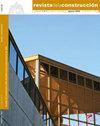工业废料对含锐钛矿- tio2混凝土自洁性能的影响
IF 1.4
4区 工程技术
引用次数: 2
摘要
将存在于混凝土结构中的受自然或人为污染源污染的有机化合物以光催化作用分解的混凝土称为自洁混凝土。本研究从机械特性和物理特性两个方面对工业废料自洁混凝土进行了探索。粉煤灰、高炉矿渣和海泡石等材料作为工业废弃物被广泛应用于混凝土中。二氧化钛(TiO2)已被用作光催化材料。用0%、10%、20%和30%的工业废料和0%、1%、3%、5%的TiO2代替水泥制备尺寸为15×15×15 cm的试样。对标准固化28天后的试样进行抗压强度、单位重量和超声脉冲速度试验。采用意大利UNI 11259标准中的罗丹明- b试验和附加的苯醌试验作为自洁试验。对部分样品进行了XRF测试,用于化学分析。TiO2含量为5%的混凝土光催化性能最好。试验结果表明,从经济效益和环境效益两方面考虑,建议在自洁混凝土生产中使用10%的工业废渣本文章由计算机程序翻译,如有差异,请以英文原文为准。
Effect of industrial wastes on self-cleaning properties of concrete containing anatase-TiO2
Concrete decomposing the organic compounds on because of natural or anthropogenic contaminating sources with photocatalysis existing in its structure is called self-cleaning concrete. In this study, the self-cleaning concrete with industrial waste has been searched from the point of mechanical and physical characteristics. Fly ash, blast furnace slag and sepiolite materials has been used as industrial waste in concrete. Titanium dioxide (TiO2) has been used as photocatalysis material. Specimens with the dimensions 15×15×15 cm were produced using 0 %, 10 %, 20 % and 30 % industrial wastes and 0 %, 1 %, 3 %, 5 % TiO2 by weight instead of cement. Compressive strength, unit weight, and ultrasonic pulse velocity tests were performed on the specimens after 28 days standard cure. Rhodamine-B test in Italian UNI 11259 standard and additional Phenantroquinone test have been performed as self-cleaning test. XRF test also has been made on some of the samples for the chemical analysis. The best photocatalysis performance has showed in the concrete including 5 % TiO2. Test results show that 10 % use of industrial wastes in self-cleaning concrete production is recommended from the point of economic and environmental benefits
求助全文
通过发布文献求助,成功后即可免费获取论文全文。
去求助
来源期刊

Revista de la Construccion
工程技术-工程:土木
CiteScore
2.30
自引率
21.40%
发文量
0
期刊介绍:
The Journal of Construction is aimed at professionals, constructors, academics, researchers, companies, architects, engineers, and anyone who wishes to expand and update their knowledge about construction. We therefore invite all researchers, academics, and professionals to send their contributions for assessment and possible publication in this journal. The publications are free of publication charges.
OBJECTIVES
The objectives of the Journal of Construction are:
1. To disseminate new knowledge in all areas related to construction (Building, Civil Works, Materials, Business, Education, etc.).
2. To provide professionals in the area with material for discussion to refresh and update their knowledge.
3. To disseminate new applied technologies in construction nationally and internationally.
4. To provide national and foreign academics with an internationally endorsed medium in which to share their knowledge and debate the topics raised.
 求助内容:
求助内容: 应助结果提醒方式:
应助结果提醒方式:


